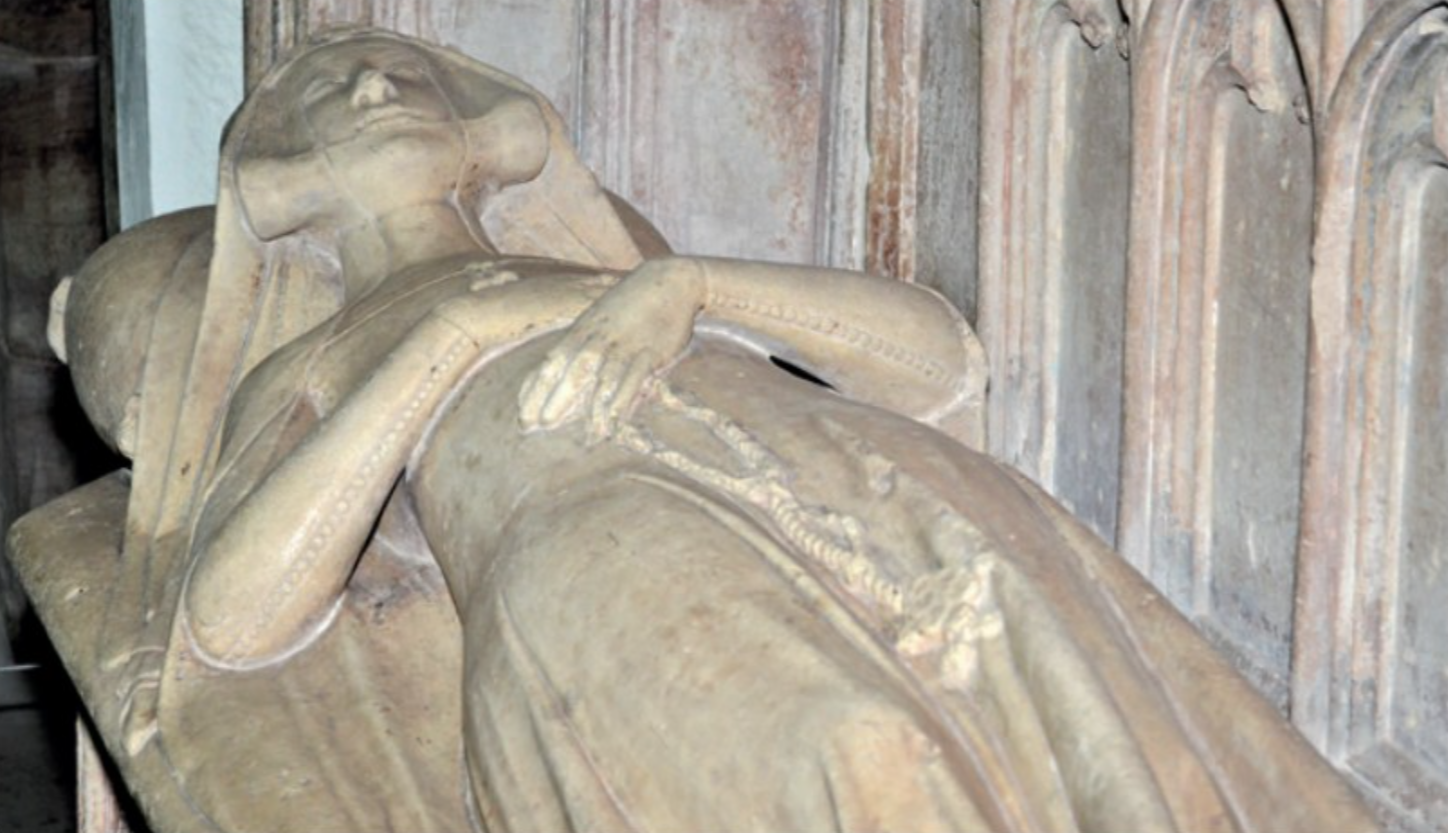The effigy of Blanche Mortimer
In St Bartholemew’s Church, Much Marcle, in deepest Herefordshire, on a canopied chest tomb, lies an astonishingly accomplished work of 14th-century sculpture: the effigy of Blanche Mortimer.
Blanche came from the long line of Mortimers who, from the 11th century to the 15th, were axial in the history of the Welsh Marches and whose family tree is intermittently entwined with royalty. She was the daughter of Roger Mortimer, first Earl of March, who joined a rebellion against Edward II, escaped Edward’s widespread vengeance by luck and trickery, and was implicated in Edward’s death. He nevertheless returned from self-exile as the lover of Edward’s widow, Queen Isabella, and usurped, in a reign of tyranny, her powers of regency over Edward III while he was still a minor. He got his ignominious comeuppance, though, when Edward came of age in 1330.
Blanche, meanwhile, appears to have led a quiet life, having married Peter Grandisson in 1320, aged 14. Peter was the nephew of Otto de Grandson, a Savoyard diplomat and lifelong friend and confidant of Edward I. Peter’s father William had been in the service of Edward’s brother Edmund, Earl of Lancaster. On their marriage, Blanche’s paternal grandmother Margaret de Fiennes, who had relatives in several European royal houses, gave the newlyweds the manor of Much Marcle. The couple lived in ‘Mortimer Castle’, the last vestiges of which lie under the grass mound adjacent to the church. Blanche died, without any surviving children, in 1347. During the conservation of the monument (2011–14) her mortal remains were discovered in the tomb chest wrapped in a leaden shroud.
Her effigy – one can not disagree with Pevsner – is ‘outstandingly beautiful’, exhibiting a realism that had artistic parallels in other parts of Europe but rarely in England. Most surviving effigies of the period follow a somewhat formulaic tradition. The exceptional precision of the carving and the minute attention to detail are such that it can not be other than a portrait. The handling of the various thicknesses of fabrics and the way they overlie each other is masterful.
She lies not in the customary rigid pose with clasped hands, but relaxed with her right knee slightly raised and her hands lying across her as if asleep. She is dressed for the journey into the hereafter: an elbow-length hooded cape of thick fabric turned back at the brow, with its excess folds carefully folded under her. Under this are a much thinner barbet and veil, secured by a jewelled circlet, proper attire for a woman of her status on a journey. The veil is carefully coiffed to ensure we can imagine her hair dressed fashionably over her ears in gold filigree nets and is swept to each side to reveal her neck. Her figure-hugging gown has sleeves buttoned or beaded from elbow to cuff and voluminous skirts. Her long cloak fastens with a tasselled cord.
On her hands are three rings and she holds an unusual seven-decade rosary, with an enormous jewelled cross; her personal devotions must have revolved round the Seven Joys of Mary. Her lop-eared dog, whose face is sadly missing, sits with his head cocked at 30 degrees on the trains of her robe and cloak, which cascade over the corner of the lid of the tomb chest, halfway to the floor. Her square-toed shoe peeks through the fabric.
Who was the sculptor? Peter Grandisson’s uncle John was Bishop of Exeter, who suspended work on the west front of the cathedral for the duration of the black-death epidemic which started in 1348. Perhaps Bishop John sent his favourite man to honour his nephew’s wife.
Blanche’s grieving husband wanted the world to see her as he did, and 675 years later it still paints us a vivid picture of an elegant and fashionable woman who died in her prime.
This article originally appeared as ‘Dressed for the journey into the hereafter’ in the Institute of Historic Building Conservation’s (IHBC’s) Context 174, published in December 2022. It was written by James Caird.
--Institute of Historic Building Conservation
Related articles on Designing Buildings
IHBC NewsBlog
200th Anniversary Celebration of the Modern Railway Planned
The Stockton & Darlington Railway opened on September 27, 1825.
Competence Framework Launched for Sustainability in the Built Environment
The Construction Industry Council (CIC) and the Edge have jointly published the framework.
Historic England Launches Wellbeing Strategy for Heritage
Whether through visiting, volunteering, learning or creative practice, engaging with heritage can strengthen confidence, resilience, hope and social connections.
National Trust for Canada’s Review of 2024
Great Saves & Worst Losses Highlighted
IHBC's SelfStarter Website Undergoes Refresh
New updates and resources for emerging conservation professionals.
‘Behind the Scenes’ podcast on St. Pauls Cathedral Published
Experience the inside track on one of the world’s best known places of worship and visitor attractions.
National Audit Office (NAO) says Government building maintenance backlog is at least £49 billion
The public spending watchdog will need to consider the best way to manage its assets to bring property condition to a satisfactory level.
IHBC Publishes C182 focused on Heating and Ventilation
The latest issue of Context explores sustainable heating for listed buildings and more.
Notre-Dame Cathedral of Paris reopening: 7-8 December
The reopening is in time for Christmas 2025.
Stirling Prize-winning Salford building to be demolished
The Centenary Building will be bulldozed as part of the wider £2.5bn Crescent regeneration project.


















Comments
[edit] To make a comment about this article, click 'Add a comment' above. Separate your comments from any existing comments by inserting a horizontal line.